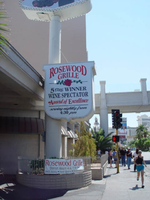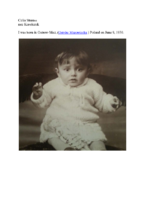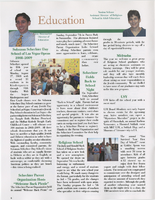Search the Special Collections and Archives Portal
Search Results

Erica Mosca oral history interview: transcript
Date
Archival Collection
Description
Oral history interview with Erica Mosca conducted by Cecilia Winchell, Stefani Evans, and Jerwin Tiu on February 3, 2023 for the Reflections: the Las Vegas Asian American and Pacific Islander Oral History Project. In this interview, Mosca reflects on her life journey from a low-income Asian American to a current serving Nevada State Assemblywoman. She recalls that most of her childhood was in Palm Springs, California where she enjoyed a diverse community of students within her education system. It was not until she moved to Navato, California where she first experienced the economic and resource gap between economically diverse areas. Mosca went on to be involved in a college readiness program and received a scholarship to Boston University. After college, Mosca went on to work for Teach for America where she was stationed on the east side of Las Vegas at Goldfarb Elementary School where she grew a passion for leadership. She eventually returned to school and graduated from Harvard University, returning to Las Vegas to start her nonprofit "Leaders in Training." Mosca hopes to inspire change in her communities by enacting legislation and initiatives targeted towards the communities she was and continutes to be a part of.
Text

Photographs of Rosewood Grille signs, Las Vegas (Nev.), 2002
Date
Archival Collection
Description
Site address: 3335 S Las Vegas Blvd
Sign owner: Alan and Kevin LeWinter
Sign details: The Rosewood Grill is between the Venetian Hotel-Casino and the Tam O'Shanter Motel on the east side of Las Vegas Blvd The facade of the building is a plain, if not unassuming white stucco structure, with a driveway running along the north side of the building. Directly in front of the buildings western wall, along the strip, a tall pylon faces north /south
Sign condition: Structure 3 Surface 3 Lighting 3
Sign form: Pylon
Sign-specific description: The pylon sign, which faces north/south, is the only signage notifying the pedestrian traffic of the establishment within. It is a tall vertical advertisement, mostly comprised of a vertical, rectangular shaped, internally lit cabinet, with rounded edges. The face of the sign is a plastic, graphically treated photo image of a man in a tuxedo holding up a giant lobster.
Sign - type of display: Incandescent; Backlit
Sign - media: Steel; Plastic
Sign - non-neon treatments: Graphics
Sign animation: Chasing, flashing
Notes: The raceway, which runs the circumference of the faces of the sign, contains small strobes placed at random places, and flashing at random patterns.
Sign environment: The sign for the establishment is the only marker that anything is operational in the dimly lit building. Not that the building looks non operational, but the majority of the building is very unassuming, mostly being denoted by the large drive and entrance. It is located just south of the Tam O'Shanter motel, among the awkward transition of the strip, that is Spring Mountain Rd. The Vagabond Inn and the Treasure Island square off the end of the block before the desolate expanse of what used to be the Desert Inn, and the transforming Fashion Show Mall, sprawl out across the north side of the road. The Rosewood Grill is part of the side of the street that trails off in size, but not character as the giant Venetian slows its progress.
Sign - date of redesign/move: Was the Anoje Continental Restaurant, next to the Kit Carson Motel, but was changed to the Rosewood Grill.
Sign - thematic influences: Not much of a theme, outside of advertising for a big lobster dinner.
Surveyor: Joshua Cannaday
Survey - date completed: 2002
Sign keywords: Chasing; Flashing; Pylon; Incandescent; Backlit; Steel; Plastic; Graphics
Mixed Content

Nadine Cracraft oral history interview: transcript
Date
Archival Collection
Description
Oral history interview with Nadine Cracraft conducted by Barbara Tabach on November 27, 2017 for the Remembering 1 October Oral History Project. In this interview, Nadine Cracraft discusses the development of her career in child and family therapy after moving to Las Vegas, Nevada in 1991. While describing the work she has done, Cracraft talks about the volunteer counseling services she provided for the survivors of the October 2017 Las Vegas mass shooting. She specifically mentions working with Aria staff members who were struggling with the aftermath of the shooting as well as her time spent working with First Friday to help those impacted by the traumatic event. Throughout the interview, Cracraft explains the different ways people manage their post-traumatic stress disorder and how this knowledge influenced her care of the survivors.
Text

Meeting minutes for Consolidated Student Senate University of Nevada, Las Vegas, March 21, 1985
Date
Archival Collection
Description
Text

Meeting minutes for Consolidated Student Senate, University of Nevada, Las Vegas, July 11, 1978
Date
Archival Collection
Description
Text

Transcript of interview with Donna Henshaw by Jeff Thompson, February 12, 1978
Date
Archival Collection
Description
On February 12, 1978, collector Jeff Thompson interviewed short-order cook and maid, Donna Henshaw (born on February 11, 1937 in Appleton, Minnesota) in the collector’s home in Las Vegas, Nevada. This interview covers the history and development of the Las Vegas area.
Text
Estelle and Julia Elliott oral history interview
Identifier
Abstract
Oral history interview with Estelle and Julia Elliott conducted by Vanessa Concepcion and Stefani Evans on December 2, 2021 for Reflections: The Las Vegas Asian American and Pacific Islander Oral History Project.
Twins Estrellita "Estelle" and Julieta "Julia" Elliott share their personal histories growing up in Cebu City, Philippines with their grandparents. They discuss moving to the United States to live with their parents after the death of their grandfather, and how they preserved their "tricultural" Castilian Spanish, Filipino, and American identities. After graduating from Stevens College, an art and academic school in Missouri, Estelle recounts marrying her husband and moving to Las Vegas where she gave birth to her daughter. Julia shares how she followed Estelle a few years later to Las Vegas, and the two women share their experiences as entertainers on the Las Vegas Strip. Both Estelle and Julia joined Minsky's Burlesque before becoming a permanent act in Siegfried and Roy's show at the Frontier Hotel. They also discuss their performances with Kirby VanBurch at the Aladdin's Abracadabra Show, dancing at the Playboy Mansion, and how Siegfried and Roy helped to diversify Las Vegas entertainment by incorporating dancers and performers of color, like the King Charles Troupe, into their shows.
Archival Collection

Biographical essay by Celia Strauss, 2014
Date
Archival Collection
Description
Celia Strauss describes her family history in Poland and fleeing the Nazis, narrowly escaping being captured or shot several times. She and her family came to the United States in 1947.
Text


